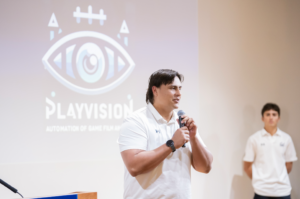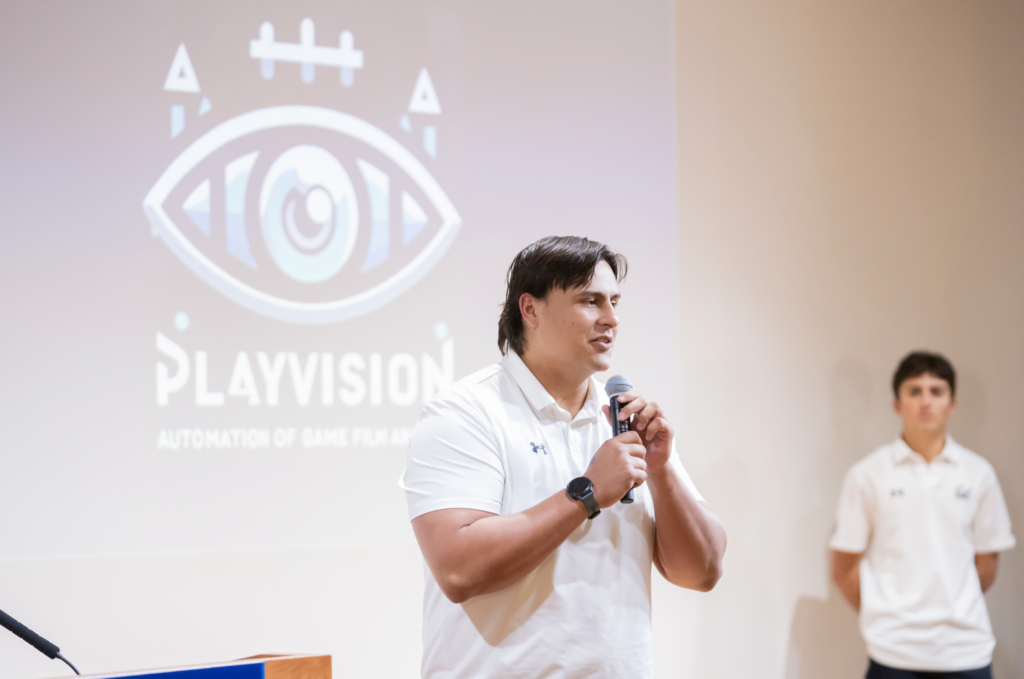Q&A: Team Playvision builds a bright future for sports tech
After winning Collider Cup XIV last May, Playvision founders Ender Aguilar, Anish Gupta and Mark Zogby are envisioning the next steps for their company. Their product, which uses computer vision to track and compile data for football sports plays, is gathering interest as the field of sports technology gains momentum.
The team found each other through SCET’s Changemaker course “Sports Tech, Entrepreneurship & the Future of Sports.” As they celebrate their success in the class and Collider Cup, CEO Ender Aguilar, CPO Anish Gupta and CCO Mark Zogby discuss the future of Playvision.
What gave you the idea for Playvision?
Ender: We created Playvision to revolutionize game film analysis. As a former Cal Division 1 football player, during the season, I spent around 20 hours each week just watching film. It was often difficult to get the most out of the raw game footage. One night I was walking home from a midterm, and I walked into my film room. I saw my coach manually entering data for each play, a process that could take two hours per game. Solving this inefficiency is what inspired the Playvision idea, and I pitched it in the Sports Tech course.
Anish: I’m a scout for Cal football, and I joined the class aiming to create something related to football. When Ender pitched this idea, it resonated with the space I work in and addressed a very relevant problem.
How did the Sports Tech course refine your initial idea?
Ender: As a football player, I have firsthand insights on the challenges and pain points that players have, and I’m also witnessing the challenges that coaches have. [Sports Tech] really helped us understand, going forward outside of class, the business side of this problem. Concepts like the Business Model Canvas were very fundamental things that helped us through this process.
Anish: Pretty much the entire second half of April was just us pitching for ten straight days to Dr. C., Peter, and a couple founders they introduced us to in the sports tech world. The connections that we were able to leverage through them were key in how we came together as a cohesive unit and ended up winning that pitch competition.
Three minutes to talk about your idea is hard. The practice we got in that class got us there, and helped us formulate this idea and decide we want to take it to a company. Thinking about aspects like the pricing model and target market really came about not only in the Collider Cup pitch, but also the pitch to investors that we’ve been doing after this.
Mark: It was exciting to see the experiential and entrepreneurial focus of the SCET course. It was cool to see how business, technology, sports, AI — all these things I’m interested in come together in the Challenge Lab classes. It’s been a very transformative experience.
Why is sports tech relevant today?
Anish: The market is booming, and we’re riding that wave. We had 12 teams total in our Sports Tech class, and each of them presented such a unique idea. The beauty of sports tech is that there’s a lot of aspects that you can build on, and a lot of sports that you can touch, all that can be beneficial.
How did integrating AI technology change your product?
Anish: One of the biggest facets of the Sports Tech class was using AI to build stuff, and it’s something prevalent that we benefit from in our product. Our company primarily operates on computer vision (CV), and AI operates with it.
Mark: Technology keeps advancing and there’s more and more data out there than can be captured, and I definitely foresee that AI will be more integrated into this type of analysis. Our AI models have already done the first round of analysis for American football. It can really bring next-level insights to the game, and transform the way sports is played and thought about.
Where do you see Playvision going in the future?
Anish: To expand within football, we’ve gotten Cal as a design partner to help with building out the product beyond the model that we’ve already shown — making sure it has a nice design and fulfills teams’ criteria. It’s an ideation that we’re trying to turn to reality. But one of our biggest selling points is, why stop at football? All sports can be optimized.
Ender: Basketball would be a huge one to get — there are more basketball teams across America than football teams — and then soccer and hockey.
Anish: The expansion is underway, so we’ve been looking for people who are interested in the data analysis part of the project. It’s mostly been us three formulating different topics, but that’s the fun of it, seeing something that you’ve created turn into a real-life thing. It’s one of the greatest feelings.
Mark: For us, it’s very cool to be part of that movement, taking the big picture and breaking it down into smaller parts that anyone can consume. It’s exciting to be improving sports competitiveness as a whole.
After winning Collider Cup XIV last May, Playvision founders Ender Aguilar, Anish Gupta and Mark Zogby are envisioning the next steps for their company. Their product, which uses computer vision to track and compile data for football sports plays, is gathering interest as the field of sports technology gains momentum.
The team found each other through SCET’s Changemaker course “Sports Tech, Entrepreneurship & the Future of Sports.” As they celebrate their success in the class and Collider Cup, CEO Ender Aguilar, CPO Anish Gupta and CCO Mark Zogby discuss the future of Playvision.
What gave you the idea for Playvision?
Ender: We created Playvision to revolutionize game film analysis. As a former Cal Division 1 football player, during the season, I spent around 20 hours each week just watching film. It was often difficult to get the most out of the raw game footage. One night I was walking home from a midterm, and I walked into my film room. I saw my coach manually entering data for each play, a process that could take two hours per game. Solving this inefficiency is what inspired the Playvision idea, and I pitched it in the Sports Tech course.
Anish: I’m a scout for Cal football, and I joined the class aiming to create something related to football. When Ender pitched this idea, it resonated with the space I work in and addressed a very relevant problem.
How did the Sports Tech course refine your initial idea?
Ender: As a football player, I have firsthand insights on the challenges and pain points that players have, and I’m also witnessing the challenges that coaches have. [Sports Tech] really helped us understand, going forward outside of class, the business side of this problem. Concepts like the Business Model Canvas were very fundamental things that helped us through this process.
Anish: Pretty much the entire second half of April was just us pitching for ten straight days to Dr. C., Peter, and a couple founders they introduced us to in the sports tech world. The connections that we were able to leverage through them were key in how we came together as a cohesive unit and ended up winning that pitch competition.
Three minutes to talk about your idea is hard. The practice we got in that class got us there, and helped us formulate this idea and decide we want to take it to a company. Thinking about aspects like the pricing model and target market really came about not only in the Collider Cup pitch, but also the pitch to investors that we’ve been doing after this.
Mark: It was exciting to see the experiential and entrepreneurial focus of the SCET course. It was cool to see how business, technology, sports, AI — all these things I’m interested in come together in the Challenge Lab classes. It’s been a very transformative experience.
Why is sports tech relevant today?
Anish: The market is booming, and we’re riding that wave. We had 12 teams total in our Sports Tech class, and each of them presented such a unique idea. The beauty of sports tech is that there’s a lot of aspects that you can build on, and a lot of sports that you can touch, all that can be beneficial.
How did integrating AI technology change your product?
Anish: One of the biggest facets of the Sports Tech class was using AI to build stuff, and it’s something prevalent that we benefit from in our product. Our company primarily operates on computer vision (CV), and AI operates with it.
Mark: Technology keeps advancing and there’s more and more data out there than can be captured, and I definitely foresee that AI will be more integrated into this type of analysis. Our AI models have already done the first round of analysis for American football. It can really bring next-level insights to the game, and transform the way sports is played and thought about.
Where do you see Playvision going in the future?
Anish: To expand within football, we’ve gotten Cal as a design partner to help with building out the product beyond the model that we’ve already shown — making sure it has a nice design and fulfills teams’ criteria. It’s an ideation that we’re trying to turn to reality. But one of our biggest selling points is, why stop at football? All sports can be optimized.
Ender: Basketball would be a huge one to get — there are more basketball teams across America than football teams — and then soccer and hockey.
Anish: The expansion is underway, so we’ve been looking for people who are interested in the data analysis part of the project. It’s mostly been us three formulating different topics, but that’s the fun of it, seeing something that you’ve created turn into a real-life thing. It’s one of the greatest feelings.
Mark: For us, it’s very cool to be part of that movement, taking the big picture and breaking it down into smaller parts that anyone can consume. It’s exciting to be improving sports competitiveness as a whole.


